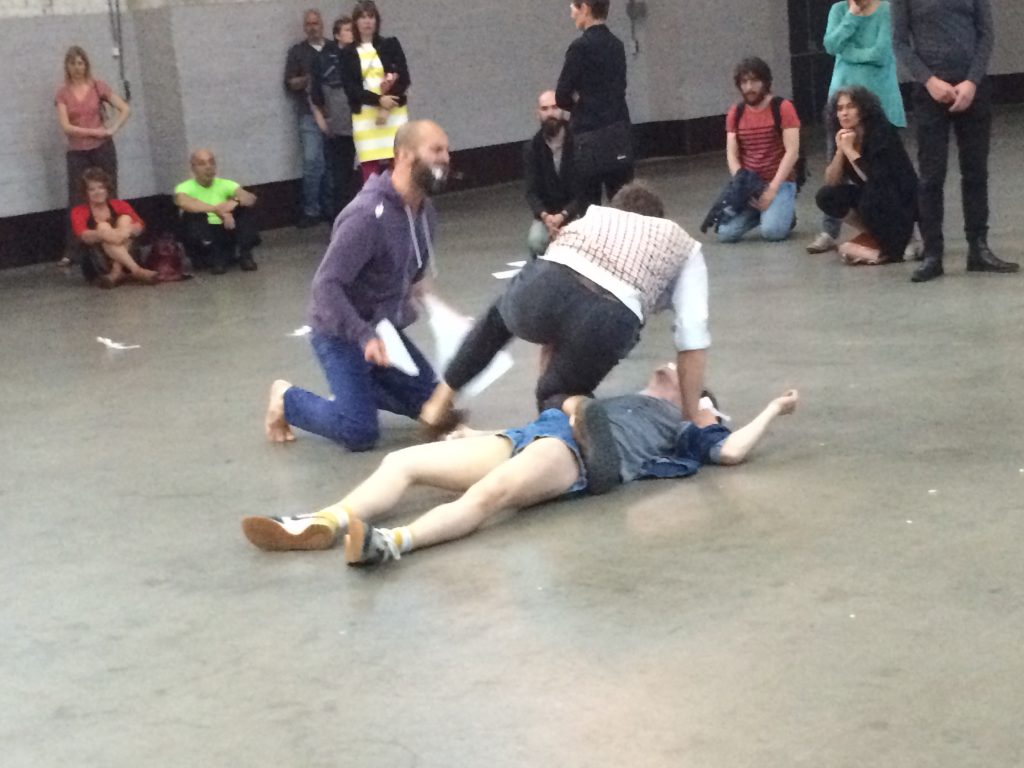Manger, the new performance by Boris Charmatz and Musée de la Danse, gives spectators all the space they need. Where you line up to watch or just to listen, who or what you watch and for how long, is up to you. The Zuiveringshal on the Westergasfabriek grounds, majestically empty and echoing, creates a wondrous atmosphere in this, for Charmatz' doing, fairly rough choreography.
Charmatz himself is a great communicator (see interview Ruhrtriënnale at the bottom of this article), but in Manger the dancers initially seem very closed off. Even when they interact, they do not seem to see each other. All exchange is through the hands, mouth and ear. Looking with the eyes is left to the audience. An audience that has no chairs at its disposal, but is also not prescribed a clear arrangement.
The audience of Manger actually opens the performance itself, as it swarms into the Purification Hall. The resonance in the hall amplifies every careless step taken, while the beauty of the old building makes spectators realise they have landed on a grand stage. Yet the exchange between dancers and audience as it begins gently chewing also has something very informal. It's just food, it's just some papers. Not quite the grandeur usually associated with prestigious art.
The precise, very attentive beginning of Manger is therefore followed by a search for how to look, listen, sit or stand, occupy a fixed spot or, on the contrary, move around a lot. Meanwhile, the dancers move mostly on the ground, increasingly forming a separate, branched construction, right through the loosely dispersed crowd and immense space. They perform their score in their time, determined by the tempo of the singing/dancing, proliferating with their space. The resulting structure, say a choreography for 14 dancers and 250 other people, yields beautiful views and vistas, but also almost intrusively intimate moments.
Touch and eating, feeling and doing, singing without looking, seems to have challenged Charmatz to create a miraculous ode to the hooligan monk. The a cappella singing and shouting, speaking and moaning connects everything and everyone. It produces wonderful moments in which an atonal choir crawls its way, or there is horizontal disco dancing to a French pop song.
Recognisable melodies and certainly the lyrics, including the beautiful and hilarious l'Homme de Merde by Christoff Tarkos, sometimes still give a reference to the actions and movements of the dancers. But mostly it is guesswork as to what you are actually experiencing. Not only the digestion of the paper inside the performers is shown in Manger hidden from view, but also what all could have been written on those auwel-A-fours - asking for all kinds of consumption I suppose.
The dancers' movements go semantically underground. You can take them as signs of something, but then you are very much doing it yourself. Digesting, taking to you, ingesting, processing and working through, becomes a subject in itself. The body is not formless - quite the contrary. But its appearance comes with so little 'style and grace' that it is more reminiscent of deep, deliciously anti-social drunkenness or intense sexual or culinary indulgence, call it hooligan joy.
As if Charmatz wants to show us the body again. A body that, despite all its health mania, has to endure quite a lot, in terms of stress as collateral damage of striving, outer and inner ideals. Or the bodies of all those people who are on their own and can no longer bring themselves to confidently address their fellows, people who are down and out, wandering. But also a body that is unashamedly out of control and shamelessly watching.
The reverberation in the hall, the ever-rising a cappella vocals, the chosen repertoire and the dancers' ever-unified performance makes Manger also some kind of congregation, religious or otherwise. No one said penance or regret, but it seems the obvious resting point amid all the physical euphoria and misery.
Manger generates a wonderful combination of theatrical viewing, museum stroll and cloister. Precisely by omitting all kinds of usual theatre and dance things, such as the fixed stand, the central gaze and a nicely stylised appearance, the performance gives the spectator all the space one would find in galleries, museums or open-air settings. However, during yet another singing session, a slightly too creamy memory also crept up on me. I needed a man with a little dog, a moped or a bird in the air, or children who don't care about anything while playing, like that man, the little dog and the bird. Not that I wanted to dance along, as some other visitors said afterwards. But the ritual became too compelling for me. Being a tourist in someone else's church, where you can't just get up and leave would be an insult. - And yet, tonight I enjoy watching it again.
Manger can still be seen on 5 and 6 June at De Zuiveringshal, Westergasfabriekterrein, Amsterdam. Starts at 20:30. For more informtion see ijdens the Holland Festival.
Charmatz interviewed ahead of the premiere of Manger during the RuhrTriennale 2014 in Bochum.


